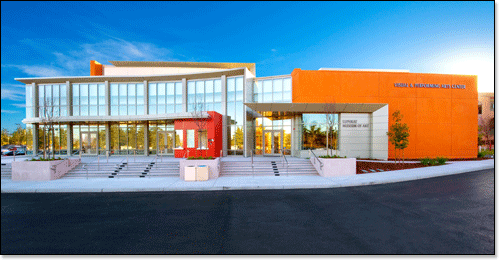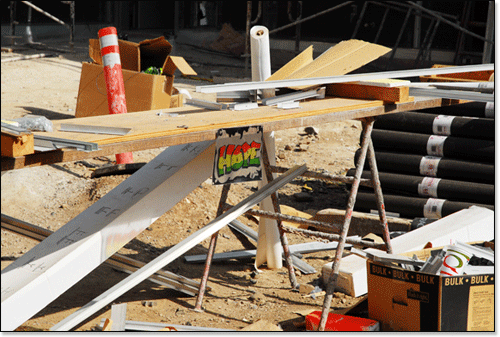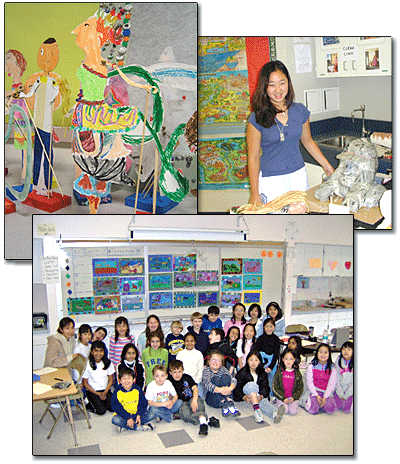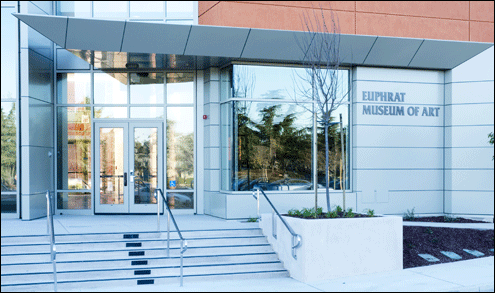"The Euphrat Museum of Art's influence on the Peninsula spans many communities, from the fine artists it presents, to the schools, centers and institutions that the Euphrat collaborates with. The Museum's work has promoted diversity and cross-cultural understanding through art and deepened our knowledge of community issues in our area. I applaud its efforts and wish it continued success."
– Richard Lowenthal, Former Cupertino Mayor
Mission
The Euphrat Museum of Art's mission is to research, produce and present challenging exhibitions and educational materials that provide a resource of visual ideas and a platform for communications. Our highly regarded Museum traditionally presents one-of-a-kind exhibitions, publications, and events reflecting the rich diverse heritage of our area. Our exhibitions highlight our heritage of different cultures; enhance understanding of art fundamentals, art history, and esthetics; and augment college instruction.
The Euphrat offers exhibitions that showcase emerging artists and artists with national and international reputations. Public programming, such as lectures and receptions, complement the exhibitions. We also present a student show featuring art by De Anza College students and include collaborative projects by elementary, middle, and high school students in major exhibitions.
"The Euphrat is a local art treasure. It reflects the values of creativity, participation, and artistic development which make it one of the most respected Museums of Art in our area. I proudly support the Euphrat and look forward to viewing future presentations in their new space."
– Dianne McKenna, Former Santa Clara County Supervisor
Our Space
 In February 2009, the Museum opened its doors to a new exhibition space connected
with the Visual and Performing Arts Center at De Anza College. The Euphrat Museum
is a signature building with a prominent location and visibility from Stevens Creek
Boulevard. In connection with a performance hall and art history classroom, it forms
a vibrant Visual and Performing Arts complex. This configuration facilitates joint
receptions, joint programming, connecting college and community users.
In February 2009, the Museum opened its doors to a new exhibition space connected
with the Visual and Performing Arts Center at De Anza College. The Euphrat Museum
is a signature building with a prominent location and visibility from Stevens Creek
Boulevard. In connection with a performance hall and art history classroom, it forms
a vibrant Visual and Performing Arts complex. This configuration facilitates joint
receptions, joint programming, connecting college and community users.
 Designed with the expertise of Mark Cavagnero, Mark Cavagnero Associates, working
with the project's DES Architects & Engineers, the interior is a clean, modern art
space, with track lighting and internet connections, flexible to serve a variety of
art installations, lectures, and events. The exhibition space has a view to Stevens
Creek Boulevard, a garden patio, and a shared lobby.
Designed with the expertise of Mark Cavagnero, Mark Cavagnero Associates, working
with the project's DES Architects & Engineers, the interior is a clean, modern art
space, with track lighting and internet connections, flexible to serve a variety of
art installations, lectures, and events. The exhibition space has a view to Stevens
Creek Boulevard, a garden patio, and a shared lobby.
An Education/Preparator Room enables student interns to work with museum professionals and provides resources and development space for our educational programming including hands-on Teaching Tours. The garden patio has multiple uses, an extended reception area and collaborative activity area. Offices, storage room, and covered delivery area provide the infrastructure for staff to borrow artwork and to develop comprehensive exhibitions.
 The "HOPE" sign was part of Building Together, the Euphrat collaborative public art project on the construction fence for the Euphrat
Museum of Art, Visual and Performing Arts Center. Construction workers liked it and
moved it around the construction site as the building progressed. (Photo by Greg W.
Serniuk)
The "HOPE" sign was part of Building Together, the Euphrat collaborative public art project on the construction fence for the Euphrat
Museum of Art, Visual and Performing Arts Center. Construction workers liked it and
moved it around the construction site as the building progressed. (Photo by Greg W.
Serniuk)
"For more than three decades, the Euphrat Museum of Art has inspired our citizens with its groundbreaking exhibits and collaborations. The Museum has fostered discussion and creativity in classrooms and in the community, and its influence is felt nationwide. We are very fortunate to have this organization in our area."
– Otto Lee, Sunnyvale City Council Member
History
The Euphrat Museum of Art was established at De Anza College in 1971 as the Helen Euphrat Art Gallery. After an extensive Museum Assessment Program study, the Euphrat evolved into the Euphrat Museum of Art in 1992, receiving mayoral proclamations from the Cities of Cupertino, Sunnyvale, and Los Altos. For over five decades, the Euphrat has presented one-of-a-kind exhibitions and events reflecting the rich diverse heritage of our area. We have featured quality contemporary exhibitions of national and international stature in various media, focusing on political, social, and historical issues. Each year the Euphrat produces three exhibitions that include emerging artists and artists with national and international reputations, plus shows featuring art by local elementary and middle school students and De Anza College students. In addition to our inter-campus connections, the Euphrat involves community members, including artists, educators, and activists, to work with us in defining exhibitions, locating artists and students, and contributing to exhibition-related public programs. We collaborate with a range of organizations outside the college, from small groups to city government agencies.
Family Roots and Naming
The Euphrat Museum of Art was named after Helen Euphrat. The Euphrat family was the last private owner of the property before its purchase by the Foothill De Anza College District as the site of the De Anza Campus (founded in 1967). E.F. and Helen Euphrat donated the original endowment for the Helen Euphrat Art Gallery. After the college was built, the Euphrats continued to live on campus, in an area that will soon be the site for a new Mediated Learning Center. Their son, Jack Euphrat, provided critical seed money to build the Euphrat Gallery programming c. 1980. Granddaughter Lisa Euphrat Saunders served on the Euphrat Council. Grandson Fred Euphrat attended the opening reception for the new Euphrat Museum of Art in February 2009.
Former Euphrat Council member Walter S. Newman, Jr., M.D. was part of the extended Euphrat family and spent summers on the Euphrat Ranch as a youth. For our inaugural exhibition of the new Euphrat, he shared this story about Emmanuel Euphrat:
"When I was very young, ‘Papa Euphrat’ read to me The Happy Prince by Oscar Wilde on more than one occasion. We both loved the story. He gave me a beautifully illustrated copy of the book, which I still have...and shall always treasure."
"Please read it to yourself and perhaps out loud to someone you love. In so doing, we honor the spirit of the apricots and the education and creativity that have blessed the lands of the Euphrat Ranch in Cupertino for so many years."
The original Euphrat Ranch centered on the Le Petit Trianon building (currently the California History Center). Designed by architect Willis Polk, part of the original Baldwin estate, built c. 1894, it was later nicknamed "le Petit Trianon," and has been listed on the National Register of Historic Places since 1970. The sunken garden and balustrade were also part of the original Baldwin Estate, which featured a reflecting pool, fruit trees, a vineyard and extensive landscaping. The cottages (formerly two) were guest and servants’ quarters. The Mission revival style architecture is said to have inspired the College’s Spanish-style design and the "arches" theme. The Winery and Cellar (currently Financial Aid) were used by the Baldwins to make their own label of wine. A Cork oak tree (Quercus suber) still stands near Flint Center, most likely planted by the Baldwins for use by their winery.
A family tree for the Euphrat family and additional historical information and photographs are being researched. For more information about the history of the campus, contact the California History Center and visit the Stocklmeir Library and Archives.



